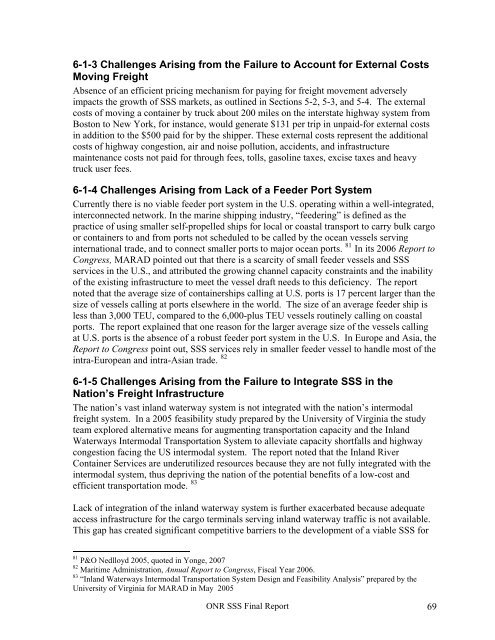Office of Naval Research - National Transportation Library
Office of Naval Research - National Transportation Library
Office of Naval Research - National Transportation Library
You also want an ePaper? Increase the reach of your titles
YUMPU automatically turns print PDFs into web optimized ePapers that Google loves.
6-1-3 Challenges Arising from the Failure to Account for External CostsMoving FreightAbsence <strong>of</strong> an efficient pricing mechanism for paying for freight movement adverselyimpacts the growth <strong>of</strong> SSS markets, as outlined in Sections 5-2, 5-3, and 5-4. The externalcosts <strong>of</strong> moving a container by truck about 200 miles on the interstate highway system fromBoston to New York, for instance, would generate $131 per trip in unpaid-for external costsin addition to the $500 paid for by the shipper. These external costs represent the additionalcosts <strong>of</strong> highway congestion, air and noise pollution, accidents, and infrastructuremaintenance costs not paid for through fees, tolls, gasoline taxes, excise taxes and heavytruck user fees.6-1-4 Challenges Arising from Lack <strong>of</strong> a Feeder Port SystemCurrently there is no viable feeder port system in the U.S. operating within a well-integrated,interconnected network. In the marine shipping industry, “feedering” is defined as thepractice <strong>of</strong> using smaller self-propelled ships for local or coastal transport to carry bulk cargoor containers to and from ports not scheduled to be called by the ocean vessels servinginternational trade, and to connect smaller ports to major ocean ports. 81 In its 2006 Report toCongress, MARAD pointed out that there is a scarcity <strong>of</strong> small feeder vessels and SSSservices in the U.S., and attributed the growing channel capacity constraints and the inability<strong>of</strong> the existing infrastructure to meet the vessel draft needs to this deficiency. The reportnoted that the average size <strong>of</strong> containerships calling at U.S. ports is 17 percent larger than thesize <strong>of</strong> vessels calling at ports elsewhere in the world. The size <strong>of</strong> an average feeder ship isless than 3,000 TEU, compared to the 6,000-plus TEU vessels routinely calling on coastalports. The report explained that one reason for the larger average size <strong>of</strong> the vessels callingat U.S. ports is the absence <strong>of</strong> a robust feeder port system in the U.S. In Europe and Asia, theReport to Congress point out, SSS services rely in smaller feeder vessel to handle most <strong>of</strong> theintra-European and intra-Asian trade. 826-1-5 Challenges Arising from the Failure to Integrate SSS in theNation’s Freight InfrastructureThe nation’s vast inland waterway system is not integrated with the nation’s intermodalfreight system. In a 2005 feasibility study prepared by the University <strong>of</strong> Virginia the studyteam explored alternative means for augmenting transportation capacity and the InlandWaterways Intermodal <strong>Transportation</strong> System to alleviate capacity shortfalls and highwaycongestion facing the US intermodal system. The report noted that the Inland RiverContainer Services are underutilized resources because they are not fully integrated with theintermodal system, thus depriving the nation <strong>of</strong> the potential benefits <strong>of</strong> a low-cost andefficient transportation mode. 83Lack <strong>of</strong> integration <strong>of</strong> the inland waterway system is further exacerbated because adequateaccess infrastructure for the cargo terminals serving inland waterway traffic is not available.This gap has created significant competitive barriers to the development <strong>of</strong> a viable SSS for81 P&O Nedlloyd 2005, quoted in Yonge, 200782 Maritime Administration, Annual Report to Congress, Fiscal Year 2006.83 “Inland Waterways Intermodal <strong>Transportation</strong> System Design and Feasibility Analysis” prepared by theUniversity <strong>of</strong> Virginia for MARAD in May 2005ONR SSS Final Report 69
















